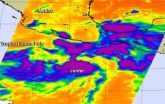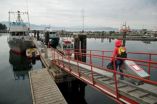(Press-News.org) We respond to infections in two fundamental ways. One, which has been the subject of intensive research over the years, is "resistance," where the body attacks the invading pathogen and reduces its numbers. Another, which is much less well understood, is "tolerance," where the body tries to minimise the damage done by the pathogen. Now an elegant study using data from a large Swiss cohort of HIV-infected individuals gives us a tantalising glimpse into why some people cope with HIV better than others.
The authors find that tolerance varies substantially between individuals, that it's determined at least partly by the genes that one inherits, and that the genes that influence tolerance of HIV are distinct from those that influence resistance. The team, led by Roland Regoes at ETH Zurich, publishes their work on 16th September in the open access journal PLOS Biology.
HIV offers a unique opportunity to tease apart the way that the human body handles disease. After the initial infection event, the virus takes up residence in a population of white blood cells called CD4+ T cells. The number of viruses a few months after infection, called the "set-point viral load," can be used to measure resistance – how well a person is fighting the virus. However, HIV infection also offers a ready measure of tolerance – the slower you lose your CD4+ T cells, the better you are tolerating the infection. This situation of cohabitation between human and virus can last many years, but when the number of CD4+ T cells falls below a critical level (fewer than 200 cells per microliter of blood) then the immune system is compromised and the HIV carrier becomes an AIDS patient, with potentially fatal consequences, if not treated.
The key to the study is the existence of the Swiss HIV Cohort Study, started in 1988, – this provided the authors with more than 3000 HIV-infected people in whom they could measure both set-point viral load and the rate of CD4+ T cell loss. These two values could be used to simultaneously assess both resistance and tolerance, and combining these with a wealth of demographic and genetic data on the same individuals allowed the authors to start to explore the workings of tolerance.
The first question they asked was whether age and sex matter. On average, they found, men and women tolerated HIV equally well, but older people had a lower tolerance, with the disease progressing almost twice as fast in a 60-year old as in a 20-year old.
The authors then looked at hereditary factors that influence tolerance of HIV. They looked at genetic differences that are known to be associated with resistance to HIV and asked whether these were also associated with tolerance. The answer was an overwhelming "no," confirming the expectation that resistance and tolerance are biologically distinct phenomena.
However, one gene that is involved in resistance also seemed to be involved in tolerance. The HLA-B gene, which encodes a protein involved in recognition of pathogens by the immune system, varies considerably between individuals. Although some of these variants are known to influence a person's resistance to HIV, the authors found that other variants of the same gene correlated with tolerance. So this key player in the immune system seems to influence both tolerance and resistance, but in distinct ways.
Surprisingly, there seemed to be no trade-off between tolerance and resistance – this had been expected from other studies, but it seemed that in this cohort of HIV carriers, tolerance and resistance could be independent or go hand-in-hand.
The authors claim that "these findings add to our understanding of how hosts tolerate infections and could open new avenues for treating infections." The exciting thing about tolerance is that – unlike resistance – it's expected to be "evolution-proof." One of the issues with achieving resistance to a virus, whether naturally or with the use of drugs is that it is in the virus's interest to develop evasive tactics that get round the resistance mechanism. However, tolerance of the virus is as much in the virus's interest as it is in the human host's, so viral evolution should not be an issue.
The work described here represents an early step in exploring the mechanism of tolerance in humans, and once we understand how tolerance works, we may then be in a position to manipulate it and help people to live with HIV more comfortably and for longer
INFORMATION:
Please mention PLOS Biology as the source for this article and include the links below in your coverage to take readers to the online, open access articles
All works published in PLOS Biology are open access, which means that everything is immediately and freely available. Use this URL in your coverage to provide readers access to the paper upon publication:
http://www.plosbiology.org/article/info:doi/10.1371/journal.pbio.1001951
Contact:
Roland R. Regoes,
Institute of Integrative Biology, ETH Zurich, Zurich, Switzerland,
roland.regoes@env.ethz.ch
Citation: Regoes RR, McLaren PJ, Battegay M, Bernasconi E, Calmy A, et al. (2014) Disentangling Human Tolerance and Resistance Against HIV. PLoS Biol 12(9): e1001951. doi:10.1371/journal.pbio.1001951
Funding: RRR acknowledges the financial support of the Swiss National Science Foundation (grant number: 315230-130855). This study has been performed within the framework of the Swiss HIV Cohort Study, supported by the Swiss National Science Foundation (grant number 33CS30_148522), and was further supported by SHCS project 697 and the SHCS research foundation. The funders had no role in study design, data collection and analysis, decision to publish, or preparation of the manuscript.
Competing Interests: The authors have declared that no competing interests exist.
The genetics of coping with HIV
2014-09-16
ELSE PRESS RELEASES FROM THIS DATE:
Point-of-care CD4 testing is economically feasible for HIV care in resource-limited areas
2014-09-16
A new point-of-care test to measure CD4 T-cells, the prime indicator of HIV disease progression, can expedite the process leading from HIV diagnosis to antiretroviral therapy (ART) and improve clinical outcomes. Now a study by Massachusetts General Hospital (MGH) investigators, working in collaboration with colleagues in Mozambique and South Africa, indicates that routine use of point-of-care CD4 testing at the time of HIV diagnosis could be cost effective in countries where health care and other resources are severely limited. Their analysis is being published in the ...
Nanoribbon film keeps glass ice-free
2014-09-16
Rice University scientists who created a deicing film for radar domes have now refined the technology to work as a transparent coating for glass.
The new work by Rice chemist James Tour and his colleagues could keep glass surfaces from windshields to skyscrapers free of ice and fog while retaining their transparency to radio frequencies (RF).
The technology was introduced this month in the American Chemical Society journal Applied Materials and Interfaces.
The material is made of graphene nanoribbons, atom-thick strips of carbon created by splitting nanotubes, ...
Journal of Clinical Psychiatry: Long-term benefit of NeuroStar TMS Therapy in depression
2014-09-16
Malvern, Pennsylvania, September 16, 2014 – Neuronetics, Inc., today announced that results of a study designed to assess the long-term effectiveness of NeuroStar TMS Therapy in adult patients with Major Depressive Disorder (MDD) who have failed to benefit from prior treatment with antidepressant medications, were published online in The Journal of Clinical Psychiatry. The study found that TMS treatment with the NeuroStar TMS Therapy System induced statistically and clinically meaningful response and remission in patients with treatment resistant MDD during the acute phase ...
NASA spots center of Typhoon Kalmaegi over Hainan Island, headed for Vietnam
2014-09-16
NASA's Aqua satellite saw Typhoon Kalmaegi's center near northern Hainan Island, China when it passed overhead on September 16 at 06:00 UTC (2 a.m. EDT). Hours later, the storm crossed the Gulf of Tonkin, the body of water that separates Hainan Island from Vietnam, and was making landfall there at 11:30 a.m. EDT.
The Moderate Resolution Imaging Spectroradiometer or MODIS instrument aboard Aqua captured a picture of the typhoon that shows the center near the northern end of Hainan Island, China, while the storm stretches over the mainland of southeastern China, east into ...
Computerized emotion detector
2014-09-16
Face recognition software measures various parameters in a mug shot, such as the distance between the person's eyes, the height from lip to top of their nose and various other metrics and then compares it with photos of people in the database that have been tagged with a given name. Now, research published in the International Journal of Computational Vision and Robotics looks to take that one step further in recognizing the emotion portrayed by a face.
Dev Drume Agrawal, Shiv Ram Dubey and Anand Singh Jalal of the GLA University, in Mathura, Uttar Pradesh, India, suggest ...
Newborn Tropical Storm Polo gives a NASA satellite a 'cold reception'
2014-09-16
The AIRS instrument aboard NASA's Aqua satellite uses infrared light to read cloud top temperatures in tropical cyclones. When Aqua passed over newborn Tropical Storm Polo off of Mexico's southwestern coast it got a "cold reception" when infrared data saw some very cold cloud top temperatures and strong storms within that hint at intensification.
Polo formed close enough to land to trigger a Tropical Storm Watch for the southwestern coast of Mexico. The watch was issued by the government of Mexico on September 16 and extends from Zihuatanejo to Cabo Corrientes, Mexico. ...
EARTH Magazine: The Bay Area's next 'big one could strike as a series of quakes
2014-09-16
Alexandria, Va. — Most people are familiar with the Great 1906 San Francisco Earthquake and are aware of the earthquake risk posed to the Bay Area — and much of California — by the San Andreas Fault. Most people are not aware, however, that a cluster of large earthquakes struck the San Andreas and quite a few nearby faults in the 17th and 18th centuries. That cluster, according to new research, released about the same amount of energy throughout the Bay Area as the 1906 quake. Thus, it appears that the accumulated stress on the region's faults could be released in a series ...
New research decodes virus-host interactions in ocean dead zones
2014-09-16
A complex web of interaction between viruses, bacteria, and their environment is becoming ever more untangled by a growing international collaboration between Matthew Sullivan, associate professor in the University of Arizona's Department of Ecology and Evolutionary Biology and Steven Hallam from the University of British Columbia in Vancouver, Canada.
"Bacteria are drivers of nutrient and energy cycles that power the earth," Sullivan said. "As the climate is changing, so are the environments these bacteria live in, and they in turn loop back to impact their environments. ...
New research shows tornadoes occurring earlier in 'Tornado Alley'
2014-09-16
BOZEMAN, Mont. -- Peak tornado activity in the central and southern Great Plains of the United States is occurring up to two weeks earlier than it did half a century ago, according to a new Montana State University study whose findings could help states in "Tornado Alley" better prepare for these violent storms.
Tornado records from Nebraska, Kansas, Oklahoma, and northern Texas – an area of high tornado activity dubbed "Tornado Alley" -- show that peak tornado activity is starting and ending earlier than it did 60 years ago.
Peak tornado activity, which occurs ...
Long-term results of RTOG 0236 confirm good primary tumor control, positive 5-year survival rates
2014-09-16
San Francisco, September 15, 2014—Patients with inoperable, early-stage lung cancer who receive stereotactic body radiation therapy (SBRT) have a five-year survival rate of 40 percent, according to research presented today at the American Society for Radiation Oncology's (ASTRO's) 56th Annual Meeting. Such a positive survival rate is encouraging considering that historically conventional RT resulted in poor tumor control for patients with inoperable lung cancer. This study is an update of RTOG 0236, originally published in 2010 , and also conducted by the original researchers ...


